On April 10, 2024, the European Commission issued Implementing Regulation (EU) 2024/1037, (EU) 2024/1047, (EU) 2024/1046, and (EU) 2024/1048, having regard to Regulation (EU) 2015/2283 of the European Parliament and of the Council of 25 November 2015 on novel foods, authorizing the placing on the market of monosodium salt of L-5-methyltetrahydrofolic acid, 3'-Sialyllactose sodium salt produced using a derivative strain of Escherichia coli W (ATCC 9637), beta-glucan from Euglena gracilis microalgae, and protein concentrate from Lemna gibba and Lemna minor as a novel food. These Regulations enter into force from April 30, 2024.
On April 11, 2024, the European Commission issued Implementing Regulation (EU) 2024/1052, authorizing the placing on the market of calcidiol monohydrate as a novel food. This Regulation enters into force from May 1, 2024.
Moreover, the the European Commission amended the specifications and conditions of use of 3 already authorised novel foods, namely astaxanthin-rich oleoresin from Haematococcus pluvialis algae, lactitol, and galacto-oligosaccharide.
Authorised novel foods
1. Monosodium salt of L-5-methyltetrahydrofolic acid
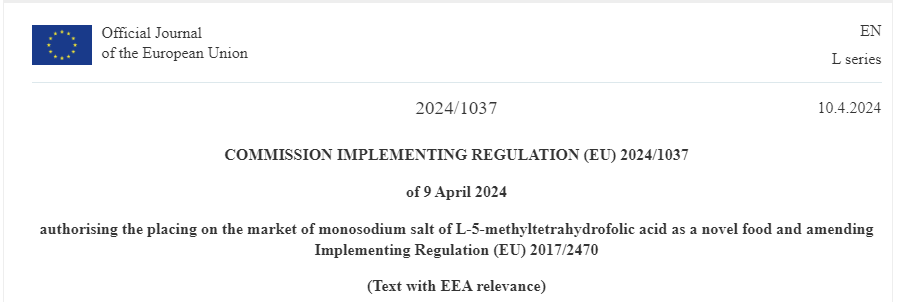
Applicant: Merck & Cie KmG (Switzerland)
Only the company Merck & Cie KmG is authorised to place on the market within the Union the novel food referred to in Article 1, for 5 years from 30 April 2024, unless a subsequent applicant obtains an authorisation for that novel food without reference to the scientific data protected pursuant to Article 3 or with the agreement of Merck & Cie KmG.
Specified food categories and maximum levels are as follows:
|
Monosodium salt of L-5-methyltetrahydrofolic acid |
Conditions under which the novel food may be used |
|
|
Specified food category |
Maximum levels (expressed as folic acid) |
|
|
Food supplements as defined in Directive 2002/46/EC, excluding food supplements for infants and young children |
In accordance with Directive 2002/46/EC |
|
|
Infant formula and follow-on formula as defined in Regulation (EU) No 609/2013 |
In accordance with Regulation (EU) No 609/2013 |
|
|
Processed cereal-based foods and baby foods for infants and young children as defined in Regulation (EU) No 609/2013 |
In accordance with Regulation (EU) No 609/2013 |
|
|
Foods for special medical purposes as defined in Regulation (EU) No 609/2013 |
In accordance with Regulation (EU) No 609/2013 |
|
|
Total diet replacement for weight control as defined in Regulation (EU) No 609/2013 |
In accordance with Regulation (EU) No 609/2013 |
|
|
Food fortified in accordance with Regulation (EC) No 1925/2006 |
In accordance with Regulation (EC) No 1925/2006 |
|
|
Additional specific labelling requirements |
||
|
1. The designation of the novel food on the labelling of the foodstuffs containing it shall be “Monosodium salt of L-5-methyltetrahydrofolic acid (folic acid)”. 2. The labelling of food supplements containing monosodium salt of L-5-methyltetrahydrofolic acid shall bear a statement that the food supplements should not be consumed by infants and young children (children under 3 years of age). |
||
2. 3’-Sialyllactose sodium salt produced using a derivative strain of Escherichia coli W (ATCC 9637)
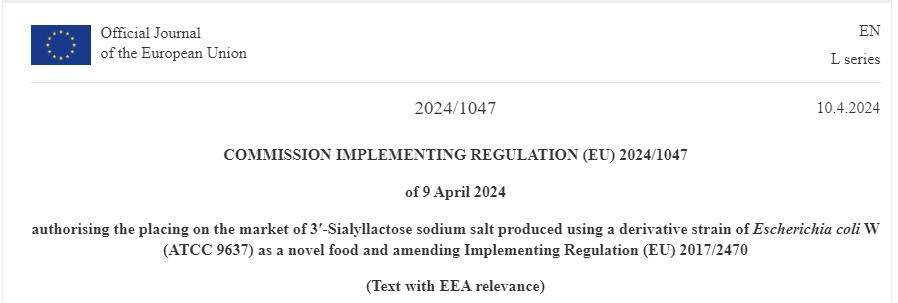
Applicant: Kyowa Hakko Bio Co., Ltd (Japan)
Only the company Kyowa Hakko Bio Co., Ltd. is authorised to place on the market within the Union the novel food referred to in Article 1, for a period of 5 years from 30 April 2024, unless a subsequent applicant obtains authorization for that novel food without reference to the scientific data protected pursuant to Article 3 or with the agreement of Kyowa Hakko Bio Co., Ltd.
Specified food categories and maximum levels are as follows:
|
3’-Sialyllactose sodium salt produced using a derivative strain of Escherichia coli W (ATCC 9637) |
Conditions under which the novel food may be used |
|
|
Specified food category |
Maximum levels (expressed as 3’-Sialyllactose) |
|
|
Unflavoured pasteurised and unflavoured sterilised (including UHT) milk products |
0.25 g/L |
|
|
Unflavoured fermented milk-based products |
0.25 g/L (beverages) |
|
|
0.5 g/kg (products other than beverages) |
||
|
Flavoured fermented milk-based products including heat-treated products |
0.25 g/L (beverages) |
|
|
2.5 g/kg (products other than beverages) |
||
|
Beverages (flavoured drinks, excluding drinks with a pH less than 5) |
0.25 g/L |
|
|
Cereal bars |
2.5 g/kg |
|
|
Infant formula as defined under Regulation (EU) No 609/2013 |
0.2 g/L in the final product ready for use, marketed as such or reconstituted as instructed by the manufacturer |
|
|
Follow-on formula as defined under Regulation (EU) No 609/2013 |
0.15g/L in the final product ready for use, marketed as such or reconstituted as instructed by the manufacturer |
|
|
Processed cereal-based food and baby food for infants and young children as defined under Regulation (EU) No 609/2013 |
0.15g/L (beverages) in the final product ready for use, marketed as such or reconstituted as instructed by the manufacturer |
|
|
1.25 g/kg for products other than beverages |
||
|
Milk-based drinks and similar products |
0.15g/L (beverages) in the final product ready for use, marketed as such or reconstituted as instructed by the manufacturer |
|
|
Total diet replacement foods for weight control as defined under Regulation (EU) No 609/2013 |
0.5 g/L (beverages) |
|
|
5.0 g/kg (products other than beverages) |
||
|
Food for special medical purposes as defined under Regulation (EU) No 609/2013 |
In accordance with the particular nutritional requirements of the persons for whom the products are intended |
|
|
Food supplements as defined in Directive 2002/46/EC, excluding food supplements for infants and young children |
1.0 g/day |
|
|
Additional specific labelling requirements |
||
|
1. The designation of the novel food on the labelling of the foodstuffs containing it shall be “3’-Sialyllactose sodium salt”. 2. The labelling of food supplements containing 3’-Sialyllactose (3’-SL) sodium salt shall bear a statement that they should not be consumed: (a) if foods containing added 3’-Sialyllactose sodium salt are consumed on the same day; (b) by children under 3 years of age. |
||
3. Beta-glucan from Euglena gracilis microalgae
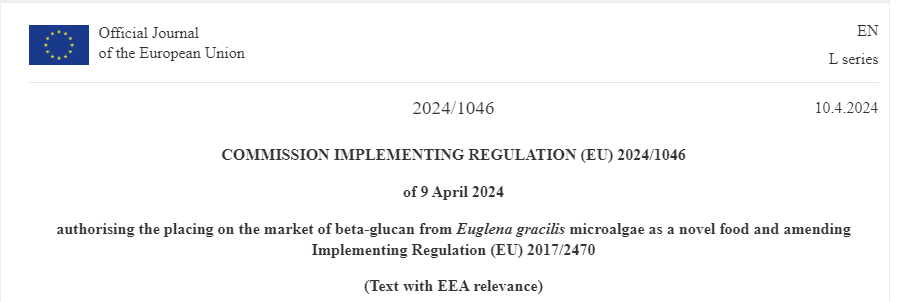
Applicant: Kemin Foods L.C. (USA)
Only the company Kemin Foods L.C. is authorised to place on the market within the Union the novel food referred to in Article 1, for a period of 5 years from 30 April 2024, unless a subsequent applicant obtains an authorisation for that novel food without reference to the scientific data protected pursuant to Article 3 or with the agreement of Kemin Foods L.C.
Specified food category and maximum levels are as follows:
|
Beta-glucan from Euglena gracilis microalgae |
Conditions under which the novel food may be used |
||
|
Specified food category |
Maximum levels |
||
|
Cereal bars |
670 mg/100 g |
||
|
Total diet replacement for weight control as defined in Regulation (EU) No 609/2013 |
670 mg/day |
||
|
Food supplements as defined in Directive 2002/46/EC, excluding food supplements for infants and young children |
100 mg/day for children from 3 to 9 years of age |
||
|
150 mg/day for children from 10 to 17 years of age |
|||
|
200 mg/day for adults |
|||
|
Additional specific labelling requirements |
|||
|
1. The designation of the novel food on the labelling of the foodstuffs containing it shall be “beta-glucan from Euglena gracilis microalgae”. 2. The labelling of food supplements containing the novel food shall bear a statement that they should only be consumed by persons above 3 years of age/above 9 years of age/adults, depending on the age group the product is intended for. |
|||
4. Protein concentrate from Lemna gibba and Lemna minor
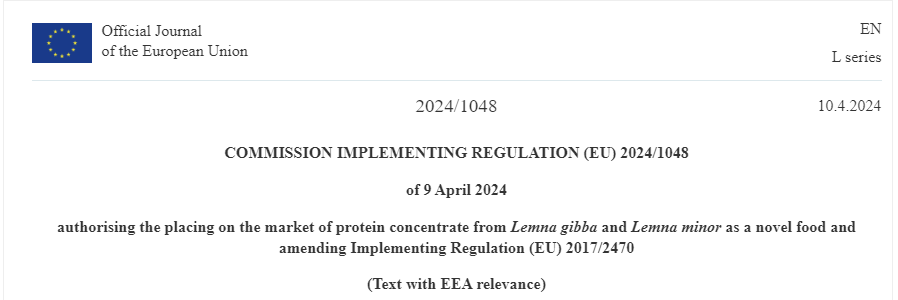
Applicant: ABC Kroos BV (Netherlands)
Only the company ABC Kroos BV is authorised to place on the market within the Union the novel food referred to in Article 1, for a period of 5 years from 30 April 2024, unless a subsequent applicant obtains an authorisation for that novel food without reference to the scientific data protected pursuant to Article 3 or with the agreement of ABC Kroos BV.
Specified food categories and maximum levels are as follows:
|
Protein concentrate from Lemna gibba and Lemna minor |
Conditions under which the novel food may be used |
||
|
Specified food category |
Maximum levels |
||
|
Cereal bars |
10 g/100 g |
||
|
Prepacked bread and rolls |
1.7 g/100 g |
||
|
Powdered drink mixes |
20 g/100 g |
||
|
Noodles |
6 g/100 g |
||
|
Food supplements as defined in Directive 2002/46/EC for the adult population |
1 g/day |
||
|
Additional specific labelling requirements |
|||
|
1. The designation of the novel food on the labelling of the foodstuffs containing it shall be “protein concentrate from the Lemna gibba and Lemna minor plants” or “protein concentrate from the Lemna gibba plant” depending on the presence of Lemna minor. 2. Where foods containing the novel food include an amount of vitamin K that is considered significant in accordance with point 2 of Part A of Annex XIII to Regulation (EU) No 1169/2011, the nutrition declaration shall indicate the amount of vitamin K. 3. The labelling of food supplements containing the novel food shall bear a statement that they should only be consumed by adults. 4. Where food supplements containing the novel food include an amount of vitamin K that is considered significant in accordance with point 2 of Part A of Annex XIII to Regulation (EU) No 1169/2011 and Article 8 of Directive 2002/46/EC, the labelling of food supplements containing novel food shall indicate the amount of vitamin K. |
|||
5. Calcidiol monohydrate
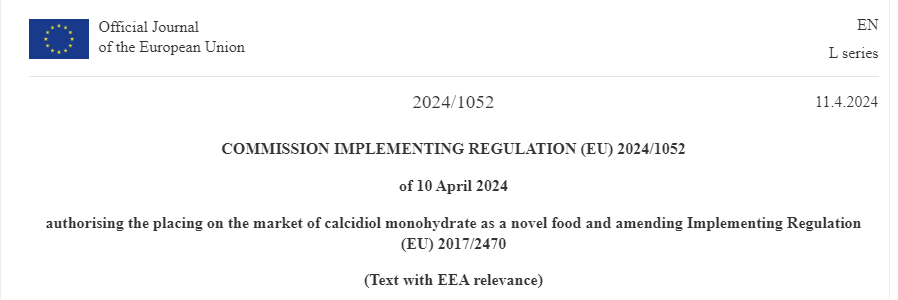
Applicant: DSM Nutritional Products Ltd. (Switzerland)
Only the company DSM Nutritional Products Ltd. is authorised to place on the market within the Union the novel food referred to in Article 1, for a period of 5 years from 1 May 2024, unless a subsequent applicant obtains an authorisation for that novel food without reference to the scientific data protected pursuant to Article 3 or with the agreement of DSM Nutritional Products Ltd.
Specified food categories and maximum levels are as follows:
|
Calcidiol monohydrate |
Conditions under which the novel food may be used |
|
|
Specified food category |
Maximum levels |
|
|
Food supplements as defined in Directive 2002/46/EC, excluding food supplements for infants and young children |
10 μg/day for children from 11 years of age and adults 5 μg/day for children from 3 to 10 years of age |
|
|
Additional specific labelling requirements |
||
|
1. The designation of the novel food on the labelling of the foodstuffs containing it shall be “calcidiol (calcifediol) monohydrate (vitamin D)”. 2. The labelling of food supplements containing the novel food shall bear a statement that they should not be consumed by infants and children under 3 years of age/children under 11 years of age, depending on the age group the product is intended for. |
||
Amended novel foods
1. Astaxanthin-rich oleoresin from Haematococcus pluvialis algae
On April 9, 2024, the European Commission issued Implementing Regulation (EU) 2024/1026, amending the specifications of the novel food astaxanthin-rich oleoresin from Haematococcus pluvialis algae. This Regulation shall enter into force on the twentieth day following that of its publication in the Official Journal of the European Union.

In Table 2 (‘Specifications’) of the Annex to Implementing Regulation (EU) 2017/2470, the entry for ‘Astaxanthin-rich oleoresin from Haematococcus pluvialis algae’ is replaced by the following:
|
Authorised Novel Food |
Specification |
|
Astaxanthin-rich oleoresin from Haematococcus pluvialis algae |
Description: Astaxanthin is a carotenoid produced by Haematococcus pluvialis algae. Production methods for the growth of the algae are variable; using “closed” systems exposed to sunlight or strictly controlled illuminated light alternatively open ponds may be used. The algal cells are harvested and dried; the oleoresin is extracted using either supercritical CO2 or a solvent (ethyl acetate). The Astaxanthin is diluted and standardized to 2,5 %, 5,0 %, 7,0 %, 10 %, 15 %, or 20 % using olive oil, safflower oil, Sunflower oil or MCT (Medium Chain Triglycerides). |
|
Characteristics/Composition
Specification of Carotenoids (% w/w)
|
|
|
Microbiological criteria:
|
2. Lactitol
On April 9, 2024, the European Commission issued Implementing Regulation (EU) 2024/1023, amending the conditions of use of the novel food lactitol. This Regulation shall enter into force on the twentieth day following that of its publication in the Official Journal of the European Union.

In Table 1 (Authorised novel foods) of the Annex to Implementing Regulation (EU) 2017/2470, the entry for ‘Lactitol’ is replaced by the following:
|
Conditions under which the novel food may be used |
||
|
Authorised novel food |
Specified food category |
Maximum levels |
|
Lactitol |
Food supplements as defined in Directive 2002/46/EC intended for the adult population |
20g/day |
|
Additional specific labelling requirements |
||
|
The designation of the novel food on the labelling of the food supplements containing it shall be “Lactitol”. |
||
3. Galacto-oligosaccharide
On April 9, 2024, the European Commission issued Implementing Regulation (EU) 2024/1027, amending the conditions of use of the novel food galacto-oligosaccharide. This Regulation shall enter into force on the twentieth day following that of its publication in the Official Journal of the European Union.

In Table 2 (‘Specifications’) of the Annex to Implementing Regulation (EU) 2017/2470, the entry for ‘Galacto-oligosaccharide’ is replaced by the following:
|
Authorised novel food |
Specification |
|
galacto-oligosaccharide |
Description/Definition: Galacto-oligosaccharide is produced from milk lactose by an enzymatic process using β-galactosidases from Aspergillus oryzae, Bifidobacterium bifidum, Pichia pastoris, Sporobolomyces singularis, Kluyveromyces lactis and Papiliotrema terrestris. GOS: min 46 % Dry Matter (DM) Lactose: max. 40 %, DM Glucose: max. 22 %, DM Ash: max. 4.0 %, DM Protein: max. 4.5%, DM Nitrite: max. 2mg/kg |
Source: Official Journal of the European Union
If you need any assistance or have any questions, please get in touch with us via service@hfoushi.com.

